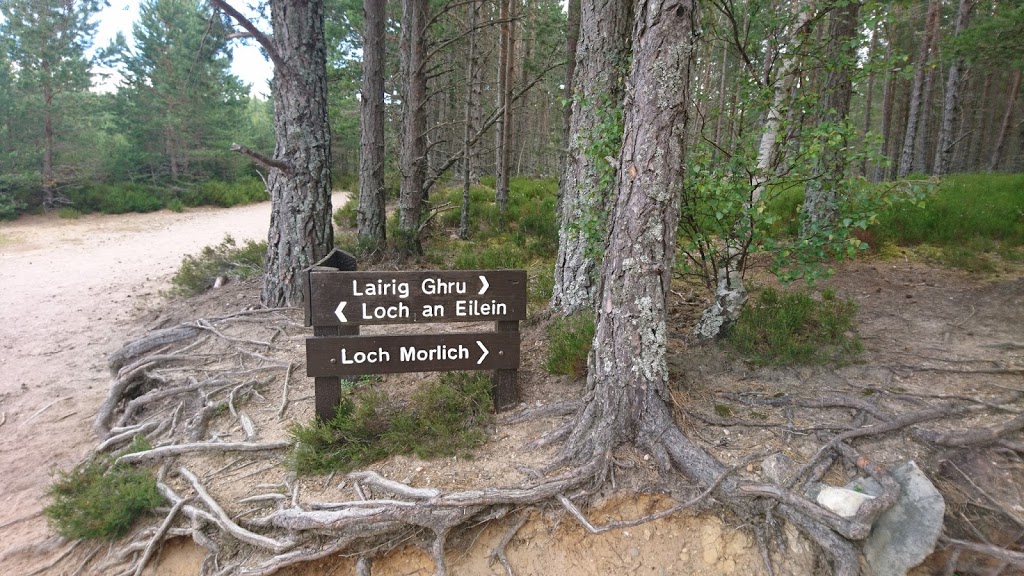The Lairig Ghru is a remote hill-pass walk, that crosses the wilds of the Cainrgorms National Park, from Speyside to Deeside. From start to finish, it takes around 8-10 hours. If you plan to drive to the area, it can be bothersome to get back to your start point again. A much better option is camping overnight and making your way back to your start point on foot the next day. This way there is no pressure for return and you can enjoy the isolated wilderness of the Lairig Ghru for an extra day.
Start Point
Of course you can begin from whichever end of the trail you wish. For the sake of this guide, we started at Loch Aa Eilein. The Rothiemurchus Camp and Caravan park is a beautiful and fairly wild campsite, ideally situated at the start of the Lairig Ghru trail. Camping here meant we could organise our gear as a group the night before and start our hike bright and early.
The first part of the walk was at a very minor uphill gradient, taking you around Loch an Eilein. Passing over a small bridge and up through the pine trees in Rothiemurchus Forest, you follow some well used mountain bike trails (be ready to jump out of the way!). As you ascend through the tall, shadowy forest, the views behind become more and more dramatic. The forest begins to thin out and the path becomes less busy. This is the point where you really feel you are heading into the barren Highland landscape.
The wilderness
Once out of the forest, the trail aims for a dramatic Glen in the distance: the Lairig Ghru. The path is far more rugged and less purposeful than the previous paths. The mountain bikers have dissipated and you are now surrounded by silence and nature. Following a ridge, there is a fast-flowing stream to your right. As the path steepens, this is an ideal time to stop for lunch. Look out for ducks paddling in the water, and enjoy the view behind you. Make sure you are refueled, as the next section of the hike is a bit tougher.
Boulder-Dash
This section of the walk is well-known, as it is honestly a pain in the ass. But this is why you’ve refueled! The boulders are remnants of the glacier that shaped the Lairig Ghru. Keep your bearings in check and watch your ankles, as the path is slightly harder to follow. Eventually the boulders subside and you are rewarded with the highest point of the Glen. Stop for a break by the two stunning lochans, known as the Pools of Dee.
Downhill
With the highest section now behind you, the trail heads downwards. Soon you will see a bothy on your right. This is where we camped, though the full trail continues a little further on. The Corrour bothy is an isolated building, situated under the shadow of The Devils Point, and makes a wonderfuly peaceful camping spot. It was surprisingly busy when we arrived, so do bring your in case the bothy itself is full.
Return & Well-Needed Chippy
After a delightful camp, we returned via the exact same route the following day. My fitbit told me we had taken 76,000+ steps and my feet were achy (my feet despise flat walks!). It’s a fantastic route to take with friends or alone. The barren, untouched landscape of the Cairngorms is overwhelming and it is perfect for escaping to nature. There are multiple munros you can add on to your hike, and I highly recommend treating yourself to a chippy tea before you head home!
Top Tips:
- Walking poles – These are a saviour for balancing your way through the boulder field.
- Good boots – A necessity in all hiking, but it’s a long couple of days. So make sure they are comfy, and ankle support will help through the boulders. My Scarpa boots are the comfiest I’ve ever owned! Good liner socks (under your hiking socks) help with blisters [affiliate links].
- Water – There are no water facilities in bothies, so you will need to fill up en-route. When drinking wild water, make sure it is free flowing (not stagnant, like a loch) and check that there are no dead animals upstream. I have never had issues drinking Scotland’s mountains water. But you can always use iodine tablets or a filter bottle too.
What’s your favourite off-the-beaten track walks? I’d love to know! Drop a comment or nab me on Instagram or Facebook. And if you enjoy my blog, I always accept thanks in the form of buying me a coffee!








Now that is a great way to spend time with friends 🙂
It really was! 😀
Hey hey, wow this brings back memories of the start of our family trip on the way up to the north we stopped a night here and I did a big run from Loch Morlich to see for the first time a bothy! Loved it. And the Midges loved me : )
Hey! Thanks for reading, the midges are a nightmare! Worth putting up with though so such beautiful adventures!